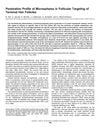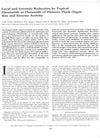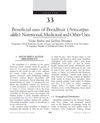TLDR Microparticles containing artocarpin extract could effectively treat hair loss and acne with minimal side effects.
The study from 2007 explored the use of alginate/chitosan (ACS) microparticles for targeted delivery of artocarpin (Ar), a compound with potential for treating androgen-dependent disorders such as male pattern alopecia and acne. The researchers developed ACS microparticles that successfully encapsulated Ar with an 18.7% entrapment efficiency and released only 0.7% of Ar over 6 hours, indicating their potential for sustained release. In an in vivo experiment with 51 hamsters, the topical application of ACS-Ar microparticles suppressed the growth of hamster flank organs, an effect comparable to a tenfold higher dose of Ar in solution form, but without significant systemic action. This suggested that ACS-Ar microparticles could be an effective and safer alternative for treating conditions like androgenic alopecia with minimal systemic effects.
 316 citations
,
June 2004 in “The journal of investigative dermatology/Journal of investigative dermatology”
316 citations
,
June 2004 in “The journal of investigative dermatology/Journal of investigative dermatology” Microspheres about 1.5 micrometers in size can best penetrate hair follicles, potentially reaching important stem cells.
47 citations
,
September 1997 in “Journal of Pharmaceutical Sciences” Properly formulated large molecules can reach active levels at the hair bulb.
 37 citations
,
November 1995 in “Journal of Investigative Dermatology”
37 citations
,
November 1995 in “Journal of Investigative Dermatology” Topical finasteride and flutamide reduce gland size and enzyme activity, with flutamide being more potent, potentially treating acne, seborrhea, hirsutism, and androgenic alopecia.
 4 citations
,
December 2009 in “Elsevier eBooks”
4 citations
,
December 2009 in “Elsevier eBooks” Breadfruit is nutritious and has potential health and medicinal benefits, but is currently underused.
 26 citations
,
March 2014 in “International journal of pharmaceutics”
26 citations
,
March 2014 in “International journal of pharmaceutics” Researchers created a skin treatment that could effectively deliver medication into hair follicles.
 19 citations
,
May 2014 in “Molecules”
19 citations
,
May 2014 in “Molecules” Avicequinone C, a compound found in the Avicennia marina plant, can reduce hair loss by inhibiting a hormone linked to androgenic alopecia.
 45 citations
,
August 2011 in “Journal of Microencapsulation”
45 citations
,
August 2011 in “Journal of Microencapsulation” Chitosan microparticles improve minoxidil sulphate delivery, potentially reducing daily applications.
 59 citations
,
May 2014 in “Expert Opinion on Therapeutic Targets”
59 citations
,
May 2014 in “Expert Opinion on Therapeutic Targets” The document concludes that targeting 5α-reductase, the androgen receptor, and hair growth genes, along with using compounds with anti-androgenic properties, could lead to more effective hair loss treatments.







